Before we go to the rules for gorilla trekking, lets delve into gorilla trekking as an activity. Mountain Gorilla trekking is an activity where tourists hike through the thick forests of Africa in search of habituated gorillas. It also includes the act of observing the primates for one hour under the guidance of park Guides and Rangers. Gorilla trekking is very popular for many reasons. One is that mountain gorillas are endangered and only about 1000 remain the world. Gorillas are one of the closest relatives to humans and share about 98% of our DNA. Because of that and the fact that their behavior/family 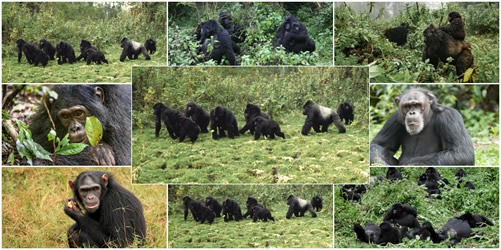 organization is similar to ours, many find them intriguing. There are only three countries where one can take part in mountain gorilla tracking. The three countries are Uganda, Rwanda and the Democratic Republic of Congo. These countries have put up precautionary measures to ensure that the gorillas are not disturbed and that their fragile environment remains intact after observing them in the wild. These precautionary measures are what we call the rules and regulations for gorilla trekking. The rules have been put in place for reasons of sustainability and conservation.
organization is similar to ours, many find them intriguing. There are only three countries where one can take part in mountain gorilla tracking. The three countries are Uganda, Rwanda and the Democratic Republic of Congo. These countries have put up precautionary measures to ensure that the gorillas are not disturbed and that their fragile environment remains intact after observing them in the wild. These precautionary measures are what we call the rules and regulations for gorilla trekking. The rules have been put in place for reasons of sustainability and conservation.
The gorilla trekking rules help maintain gorilla habitat in a natural state without any pollution from the outside. The rules also let the primates have their space and privacy such that they retain their wild nature. Furthermore, the gorilla tracking rules help avoid the spread of diseases from humans to gorillas and vice versa. Since we share a similar DNA structure, it means many of the diseases that afflict us can actually spread to the primates. Whereas we have built immunity to many of our common ailments, that cannot be said of gorillas. A simple flue can lead to the death of several members of a group or cause them to be very sick.
Before the gorilla trekking experience was introduced, the three governments worked with gorilla conservation Agencies to come up with rules and regulations that tourists would follow while tracking or in the presence of the gorillas. The rules ensure that visitors enjoy interacting with the gorillas in their natural habitat but without negatively affecting the natural environment in which they live. The gorilla trekking rules are now a conservation tool and we shall discuss them in the following chapters: –
Gorilla Trekking rules and Regulations
The minimum age for gorilla tracking is 15 years and above. It is assumed that persons below the age of 15 years are still young and may be reckless. They may not easily adhere to the rules and regulations or follow instructions by the park wardens. Though most are fit, they tend not to be mentally prepared to deal with long hours of hiking in dense and unfamiliar terrain. You can rad more about gorilla trekking with children.
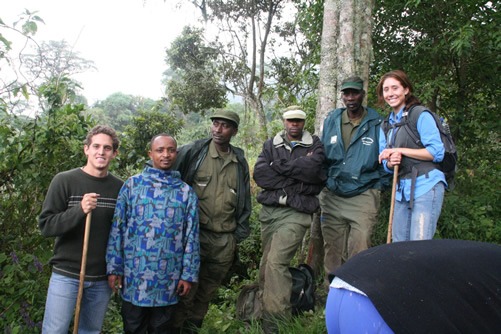 It’s important to get immunized against yellow fever and acquire the card. This card will be a requirement for crossing borders to do gorilla trekking in Bwindi, Mgahinga, Virunga or the Volcanoes National Park. Also ensure that you move with your passport. The passport will be required during any border crossing and at the park office during the briefing. The passport helps park officials know your age and see if you meet the minimum age. It also helps them know if it is your name that is on the gorilla permit. Knowing your age also helps in the allocation of gorilla groups. Older hikers are assigned gorilla families that are closer to the starting point.
It’s important to get immunized against yellow fever and acquire the card. This card will be a requirement for crossing borders to do gorilla trekking in Bwindi, Mgahinga, Virunga or the Volcanoes National Park. Also ensure that you move with your passport. The passport will be required during any border crossing and at the park office during the briefing. The passport helps park officials know your age and see if you meet the minimum age. It also helps them know if it is your name that is on the gorilla permit. Knowing your age also helps in the allocation of gorilla groups. Older hikers are assigned gorilla families that are closer to the starting point.
You cannot show up for gorilla trekking when sick or with a contagious disease. Mountain gorillas are not immune from most of the human diseases. It is therefore important to declare if you have any airborne bug. Some of the contagious diseases are flu, cold, bacterial and viral diseases. During the briefing and before heading into the forest, the park officials will advise visitors to refrain from coughing or sneezing or turn away from the primates. They are also advised to put a hand or arm around their facial area to avoid droplets from going in the direction of the gorillas.
The maximum number of people allowed to track a specific gorilla family in a day is eight. The eight people can only be with the primates for one hour. The limits are imposed to avoid having large crowds of people observing a gorilla group at the same time. The limit is also to avoid agitating the primates and to ensure that they remain wild. A large number of people could also scare them or increase the chances of one of them charging.
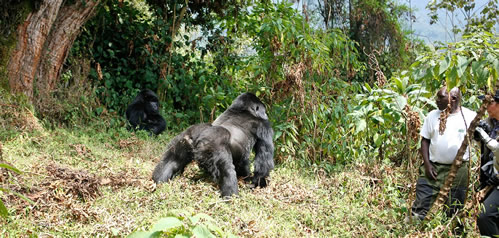 Anyone planning to do gorilla trekking should be mentally and physically read. Gorilla trekking can be a very challenging activity depending on the gorilla group one is allocated. Some of the gorilla groups live far away from the starting point. Finding them would require walking long distances and hours on hilly, steep and sloppy trails. Therefore, a person needs to be fit enough and not to tire out in the middle of the activity. The elderly gorilla trackers are always assigned the nearest families or offered porters with sedan chairs.
Anyone planning to do gorilla trekking should be mentally and physically read. Gorilla trekking can be a very challenging activity depending on the gorilla group one is allocated. Some of the gorilla groups live far away from the starting point. Finding them would require walking long distances and hours on hilly, steep and sloppy trails. Therefore, a person needs to be fit enough and not to tire out in the middle of the activity. The elderly gorilla trackers are always assigned the nearest families or offered porters with sedan chairs.
While in the forest and particularly in the presence of gorillas, trackers must lower their voices. The forest is normally a quiet place but with so many wildlife species that could easily get irritated by loud noise. It is best for trackers to keep their voices as low as possible to avoid scaring off other forest creatures like birds or smaller primates. Loud noise will force a gorilla group to move away from their resting place hence lowering the quality of your trek. Gorillas may also mistake someone talking loudly for an enemy and charge.
Don’t litter the forests. Nothing should be dropped on the ground while tracking the gorillas unless you get permission from the park Guides/Rangers. In most cases, the trackers move with polythene bags where rubbish is put. Human rubbish often contains viruses and some chemicals that could be hazardous to wildlife. Gorillas love foraging and would attempt to sniff at any unusual objects found in the forest. If the object contains human viruses or bacteria, the primates could easily get sick. Even when nature calls, a tracker must inform the park rangers and chief Guide. The park Rangers will dig a hole on the ground which the particular tourist will use as a toilet and then cover the content with soil.
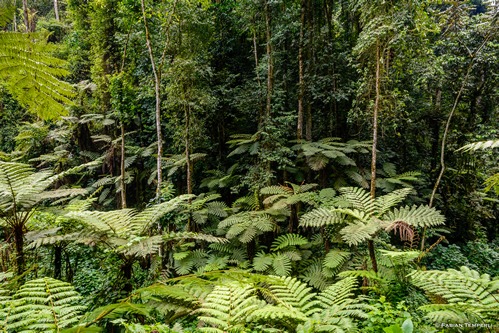 It is important to keep a distance of about 7 meters away from the nearest gorilla. By observing this distancing rule, you help alleviate the spread or transmission of human/animal diseases. The 7-meter gap is also created to leave room for the primates to move around so that they don’t compete for space with human observers. Remember that the forest is their home and you can be an intruder. A silverback will not request for space. He will simply walk towards you and push you aside. In addition, never touch a gorilla, even when it comes close to you. Never touch a baby gorilla to avoid alerting the silverback. Never appear to surround the gorillas. All trackers should be in one area to allow the primates move about or leave if they choose to. If gorillas sense that they are surrounded, they could charge.
It is important to keep a distance of about 7 meters away from the nearest gorilla. By observing this distancing rule, you help alleviate the spread or transmission of human/animal diseases. The 7-meter gap is also created to leave room for the primates to move around so that they don’t compete for space with human observers. Remember that the forest is their home and you can be an intruder. A silverback will not request for space. He will simply walk towards you and push you aside. In addition, never touch a gorilla, even when it comes close to you. Never touch a baby gorilla to avoid alerting the silverback. Never appear to surround the gorillas. All trackers should be in one area to allow the primates move about or leave if they choose to. If gorillas sense that they are surrounded, they could charge.
When a gorilla comes towards you, just step aside slowly and don’t panic. You don’t have to cause an alarm and run off. You might end up alarming the primates even further. Try to be calm and follow what the Park Rangers advise you to do at all times. Sometimes the silverback thumps up his chest to show power and control and this should not be taken for anger or irritation. Try as much as possible to avoid direct and prolonged eye contact with a gorilla. They might take it as a challenge. Gorillas are very shy primates and rarely look directly into each other’s eyes unless to communicate a message. All looking is done subtly. Gorillas also use a variety of body languages. Do not mimic any particular sound since you don’t know what it means.
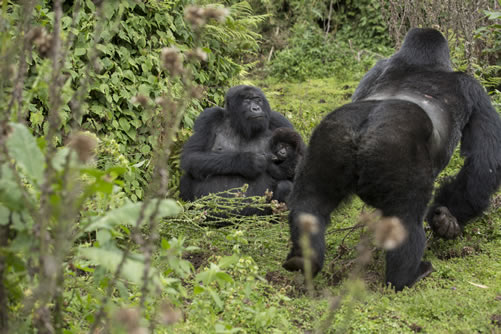 Do not start taking videos or photos of the primates until the Rangers tell you to do so. Never use flash cameras to avoid alerting the primates. The first minutes of meeting the gorillas is used to gain their trust and let them know of your presence. The park Rangers know how to make the primates comfortable since they know each individual member of the group. They need to first observe the state of the group to see if any of them is sick or having a bad day. It is only when the Park Ranger gives you the green light that you can start taking photos and videos. Please don’t forget to disable flash on the camera.
Do not start taking videos or photos of the primates until the Rangers tell you to do so. Never use flash cameras to avoid alerting the primates. The first minutes of meeting the gorillas is used to gain their trust and let them know of your presence. The park Rangers know how to make the primates comfortable since they know each individual member of the group. They need to first observe the state of the group to see if any of them is sick or having a bad day. It is only when the Park Ranger gives you the green light that you can start taking photos and videos. Please don’t forget to disable flash on the camera.
Throughout your time with the primates, you should strive not to draw attention to yourself. To that end, never put on clothes with very striking colors like red, yellow or pink while with the gorillas. You should wear jungle colors like brown, cream and dull green. Snacks or food should never be eaten in the presence of gorillas. They might want some and gorillas don’t know how to make a request.
There are other things that a tracker needs to have to make his/her gorilla trekking experience an exciting one. One is to hire a porter if they have any have bags or camera equipment. Porters can be hired at the starting point for about $15. A tracker also needs to have the right hiking boots with good traction. The tracker should also carry adequate drinking water and energy drinks. Remember to go into the forest with packed lunch or snack to avoid getting hungry. Other things to include on your packing list for gorilla trekking are insect repellents for insect bites and sanitizers for cleaning up the hands. Also remember to acquire a cap, sunglasses and a binocular for spotting birds.


